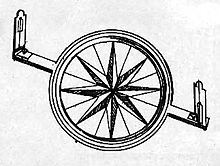This article needs additional citations for verification. (November 2023) |


A circumferentor, or surveyor's compass, is an instrument used in surveying to measure horizontal angles. It was superseded by the theodolite in the early 19th century.[1]
A circumferentor consists of a circular brass box containing a magnetic needle, which moves freely over a brass circle, or compass divided into 360 degrees.[1][2] The needle is protected by a glass covering. [2] A pair of sights is located on the North-South axis of the compass.[1] Circumferentors were typically mounted on tripods and rotated on ball-and-socket joints.[2]
Circumferentors were made throughout Europe, including in England, France, Italy, and Holland. By the early 19th century, Europeans preferred theodolites to circumferentors. However, the circumferentor remained in common use in mines and in wooded or uncleared areas, such as in America.[1][2]
- ^ a b c d Turner (1998). Scientific Instruments, 1500-1900: An Introduction. University of California Press. p. 43. ISBN 978-0-520-21728-7. Retrieved 3 July 2014.
- ^ a b c d Nesbit, Anthony; Baker, Thomas (1855). A complete Treatise on practical Land-Surveying, etc. With an engraved "Field-Book," being the notes on an estate in the Parish of Preston. pp. 343–344. Retrieved 3 July 2014.